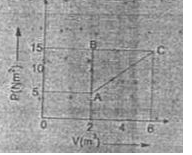In an insulated container 1 mole of a liquid. Molar volume 100 ml at 1 bar. Liquid is steeply taken to 100 bar, when volume of liquid decreases by 1 ml. Find ΔH for the process.
7900 bar ml
8900 bar ml
9900 bar ml
10900 bar ml
The correct Answer is:C
To find the change in enthalpy (ΔH) for the process described, we can follow these steps:
Step 1: Identify Initial and Final Conditions
- Initial Conditions:
- Molar volume (V1) = 100 ml
- Pressure (P1) = 1 bar
- Final Conditions:
- Final pressure (P2) = 100 bar
- Final volume (V2) = 100 ml - 1 ml = 99 ml
Step 2: Calculate Work Done (W)
The work done during a process at constant pressure can be calculated using the formula:
W=−PΔV
Where:
- ΔV=V2−V1
Substituting the values:
- V1=100ml
- V2=99ml
- ΔV=99ml−100ml=−1ml
Now, substituting into the work formula:
W=−100bar×(−1ml)=100bar ml
Step 3: Apply the First Law of Thermodynamics
According to the first law of thermodynamics:
ΔU=Q+W
Since the container is insulated, there is no heat exchange (Q = 0). Thus:
ΔU=W=100bar ml
Step 4: Relate Internal Energy Change to Enthalpy Change
The relationship between change in enthalpy (ΔH) and change in internal energy (ΔU) is given by:
ΔH=ΔU+PΔV
Step 5: Calculate PΔV
We need to calculate PΔV:
- P2=100bar
- V2=99ml
- V1=100ml
- So, PΔV=P2×(V2−V1)=100bar×(99ml−100ml)
- PΔV=100bar×(−1ml)=−100bar ml
Step 6: Substitute Values to Find ΔH
Now substituting the values into the enthalpy equation:
ΔH=ΔU+PΔV
ΔH=100bar ml+(−100bar ml)
ΔH=100bar ml−100bar ml=9900bar ml
Final Answer
Thus, the change in enthalpy (ΔH) for the process is:
ΔH=9900bar ml
---
- Initial Conditions:
- Molar volume (V1) = 100 ml
- Pressure (P1) = 1 bar
- Final Conditions:
- Final pressure (P2) = 100 bar
- Final volume (V2) = 100 ml - 1 ml = 99 ml
The work done during a process at constant pressure can be calculated using the formula:
W=−PΔV
Where:
- ΔV=V2−V1
- V1=100ml
- V2=99ml
- ΔV=99ml−100ml=−1ml
W=−100bar×(−1ml)=100bar ml
According to the first law of thermodynamics:
ΔU=Q+W
Since the container is insulated, there is no heat exchange (Q = 0). Thus:
ΔU=W=100bar ml
The relationship between change in enthalpy (ΔH) and change in internal energy (ΔU) is given by:
ΔH=ΔU+PΔV
We need to calculate PΔV:
- P2=100bar
- V2=99ml
- V1=100ml
- So, PΔV=P2×(V2−V1)=100bar×(99ml−100ml)
- PΔV=100bar×(−1ml)=−100bar ml
Now substituting the values into the enthalpy equation:
ΔH=ΔU+PΔV
ΔH=100bar ml+(−100bar ml)
ΔH=100bar ml−100bar ml=9900bar ml
Thus, the change in enthalpy (ΔH) for the process is:
ΔH=9900bar ml
Similar Questions
The given figure shows a change of state A to state C by two paths. ABC and AC for an ideal gas. Calculate the ,

(a) Path along which work done is least.
(b) Internal energy at C if the internal energy of gas at A is 10 J and amount of heat supplied to change its state to C through the path AC is 200 J.
( c) Amount of heat supplied to the gas to gd from A to B, if internal energy of gas at state B is 10 J.
(ii) In an insulated contained 1 mole of a liquid, molar volume 100 mL. is at 1 bar liquid is steeply taken to 100 bar, where volume of liquid decreases by 1 mL. Find ΔE and ΔH for the process?
(iii) 14 g of oxygen at 0∘ C and 10 atm are subjected to reversible adiabatic expansion to a pressure of 1 atm. Calculate the work done in
(i) Litre atm.
(ii) Calorie (Given, CpCv=1.4).View SolutionAn insulated contains 1mole of a liquid, molar volume 100mL at 1bar. When liquid is steeply passed to 100bar, volume decreases to 99mL. Find ΔH and ΔU for the process.
View Solution
Knowledge Check
- Question 1 - Select One
There is 1 mol liquid (molar volume 100 ml) in an adiabatic container initial, pressure being 1 bar. Now the pressure is steeply increased to 100 bar ,and the volume decreased by 1 mL under constant pressure of 100 bar. Calculate ΔHandΔE.
[Given 1 bar = 105N/m2]AΔE=0J,ΔH≠0JBΔH=990J,ΔE=10JCΔE=20J,ΔH=890JDΔE=0J,ΔH=10J
An insulated vessel contains 1mole of a liquid, molar volume 100mL at 1bar. When liquid is steeply passed to 100bar, volume decreases to 99mL. Find ΔH and ΔU for the process.
View Solution100mL of a liquid is contained in an insulated container at a pressure of 1bar. The pressure is steeply increased to 100bar. The volume of the liquid is decreased by 1mL at this constant pressure. Find ΔH and ΔU.
View Solution1 cf at liquid of molar volume 100 mL is kept in an adiabatic container under a pressure of 1 bar.The pressure is steeply increased to 100 bar.Under this constant pressure of 100 bar, the volume of the liquid decreases by 1 mL.Calculate ΔU of the process.
View SolutionThere is 1mol liquid (molar volume 100ml) in an adiabatic container initial, pressure being 1 bar Now the pressure is steeply increased to 100 bar, and the volume decreased by 1ml under constant pressure of 100 bar. Calculate ΔH and ΔE. [Given 1bar=105N/m2]
View SolutionThere is 1mol liquid (molar volume 100ml) in an adiabatic container initial, pressure being 1 bar Now the pressure is steeply increased to 100 bar, and the volume decreased by 1ml under constant pressure of 100 bar. Calculate ΔH and ΔE. [Given 1bar=105N/m2]
View SolutionPressure over 1000 ml of a liquid is gradually increases from 1 bar to 1001 bar under adiabitic conditions. If the final volume of the liquid is 990 ml, calculate ΔU and ΔH of the process, assuming linear variation of volume with pressure .
View SolutionGiven : ΔvapH at 373K=40.693kJmol−1,
Cp(H2O,l)=75.312JK−1mol−1,
Cp(H2O,g)=33.305JK−1mol−1.
Pressure over 1000 ml of a liquid is gradually increases from 1 bar to 1001 bar under adiabatic conditions. If the final volume of the liquid is 990 ml, calculate ΔUandΔH of the process, assuming linear variation of volume with pressure.View Solution

